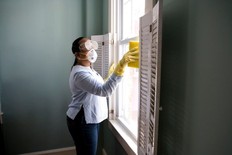Buffalo Bills Jordan Poyer only misses one game after collapsed lung
Poyer only missed one game after suffering a collapsed lung in a game versus the Baltimore Ravens on Oct. 2.

Article content
Buffalo Bills safety Jordan Poyer made the trip to Kansas City to play his next game with Patrick Mahomes and the Chiefs without his teammates.
Instead of flying on the team plane, Poyer had to ride in a van with his family after suffering a collapsed lung (pneumothorax) in a 23-20 victory over the Baltimore Ravens on Oct. 2. Amazingly, Poyer only missed one game — a 38-3 win over the Pittsburgh Steelers — due to injury.
The seventh round pick is recovering and was permitted to play by team doctors, but not fly due to concerns about the air pressure on board an airplane. Instead, Poyer had to sit in the van for 15 hours and drive for more than 1,500 kilometres.
Poyer was on the field for every single defensive play and made four tackles on Sunday. He also participated in the team’s practice on Friday.
“You want to go into a season, you want to go throughout the year, without any bumps and bruises, but that’s going to happen,” Poyer told ESPN. “Just fighting through ’em, and luckily, we’ve got a great team of trainers here that allow me to get back on the field and perform at my best.”
In the game where he suffered the lung injury, Poyer was first ruled as having a rib injury and described the feeling as “having the wind knocked out of him.” He was injured while making his second interception of the fourth quarter.
The 2021 All Pro First Team member is expected to be cleared to fly soon, but is able to save any van rides for the foreseeable future since the Bills next take on Aaron Rogers and the Green Bay Packers on Oct. 30 at home. The team will not have to travel again until Nov. 6 when they play the New York Jets.
Why couldn’t Poyer fly after being diagnosed with a collapsed lung?
Anyone who has suffered a collapsed lung, known medically as pneumothorax, shouldn’t fly for two to three weeks, according to the Aerospace Medical Association Medical Guidelines Taskforce. In 2011, a team of researchers recommended waiting at least one to two weeks after successfully treating the collapsed lung, or two weeks if an injury caused the collapsed lung.
A collapsed lung occurs when air escapes the lung, then fills the space between the lung and the inside of the chest wall, according to Penn Medicine. It’s that buildup of air on the outside of the lung that prevents it from filling as normal when breathing.
Some of the regular symptoms of a collapsed lung include sharp pain in the chest or shoulder, shortness of breath, or nasal flaring, whileless regular symptoms include blueish skin, light-headedness, fatigue, rapid heart rate, and shock.
How does a collapsed lung heal?
Less severe collapsed lungs will generally heal within one to two weeks, with rest and oxygen treatment (providing supplemental oxygen). A doctor may also use a needle to let the air surrounding the lung out so it can expand better. It’s also possible that surgery will be required depending on the location of the oxygen leak that lets the air surround the lung — this can prevent the issue from happening again in the future.
A chemical called pleurodesis can be put over the leaking area in order to seal it with a scar. Some side-effects of that procedure include chest tightness, fever, pain, and a risk of infection.
Chris Arnold is a Toronto-based writer.
DON’T MISS A THING: SIGN-UP FOR HEALTHING’S NEWSLETTER
Thank you for your support. If you liked this story, please send it to a friend. Every share counts.













